Is the New Budget DS420j NAS from Synology Worth Your Data?
Finding a home for all of your most important data in 2020 is no small task. Sure, you can slot a fair bit on your PC/Mac hard drive, but eventually, space starts to become non-existent. May users take this opportunity to invest in a reasonable network-attached storage (NAS) solution, to enable easy, swift and intuative backups of all their data over the network/internet. However, that still means you need to buy a NAS drive to store all that lovely data and with so many brands on the market, as well as a scaling price to choose from, it can be fantastically intimidating to buy your first NAS server. Synology has been a long featured brand in the arena of NAS storage in the last 10 years+ and in that time have arrived with a diverse range of solutions to suit different deployment needs and budgets. One of the latest releases to enter this arena is the Synology DS420j NAS drive. First featured back in late 2019 at the Synology 2020 event and PepCom 2020, this brand new budget NAS has arrived and promises to give you a great deal of bang for yoru buck. Featuring a familiar CPU, chassis and hardware options, it is worth seeing if this new DS420j NAS is a legitimately valid release or just the ‘same old, same old’ thing with a lick of paint. Let’s take a closer look and review the DS420j Synology NAS drive.
Synology DS420j NAS Drive – Quick Review
Synology DS420j NAS Drive – Packaging
Synology has always had a ‘less is more’ attitude to product packaging in their Diskstation NAS series. It’s a fair attitude in 2020, as the bulk of people purchasing a new Desktop NAS drive will do so at online retailers and the draw of a well designed retail packaging will be largely unnecessary. That said, they do give all the information you need on the DS420j NAS, providing details on the hardware, software, dimensions and warranty related to this new NAS drive on two stickers found on the branded brown box.
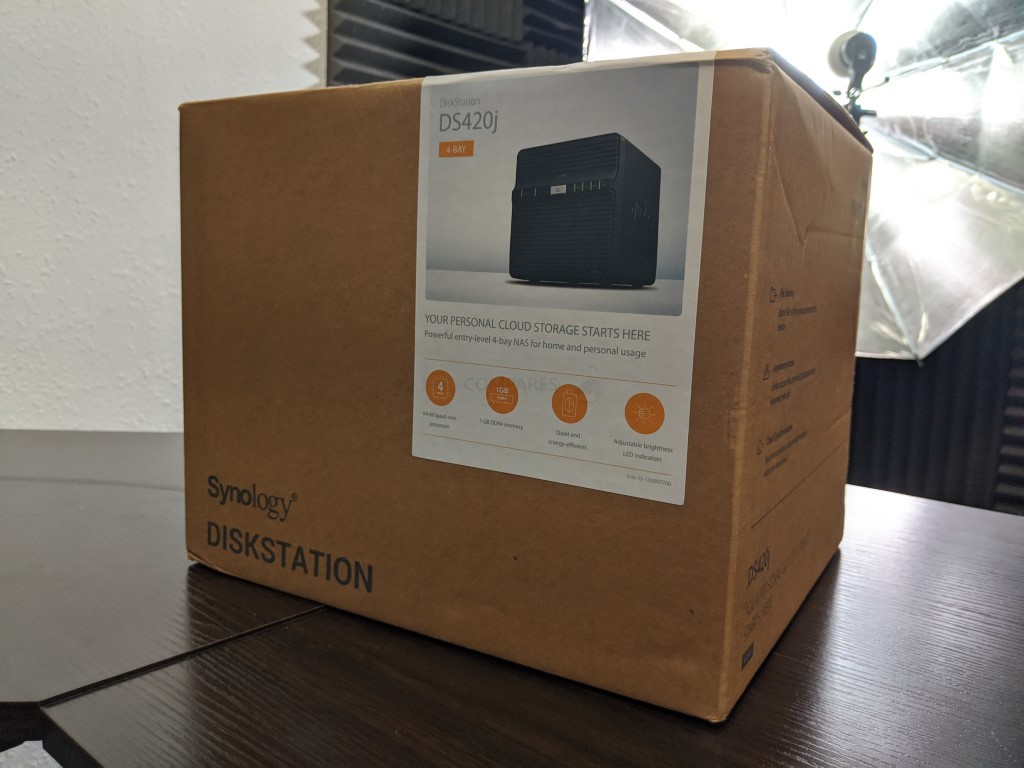
That said, the packaging of the Synology DS420j NAS is quite competent, providing a good level of transit protection and compartmentalized components inside. This is not my first time unboxing a Synology DiskStation NAS for review, and this is fairly standard packaging for the brand.
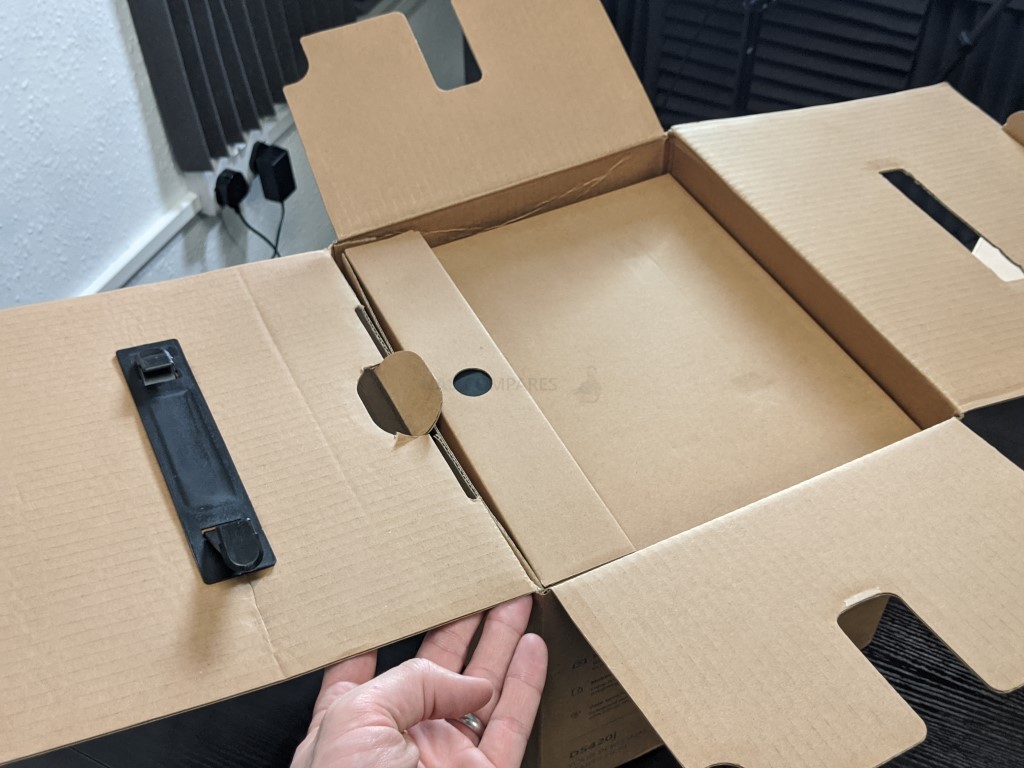
Once I removed the DS420j NAS drive and it’s protective packaging, we find the NAS unit itself, along with some standard accessories to assist you in setting up the device for the first time. This includes the DS420j NAS itself, a RJ45 LAN cable for network connectivity, an external power suppliers, a mains power outlet cable, a booklet concerning first time setup, warranty information and screws for the installation of 2.5″ and 3.5″ media in the 4-Bays
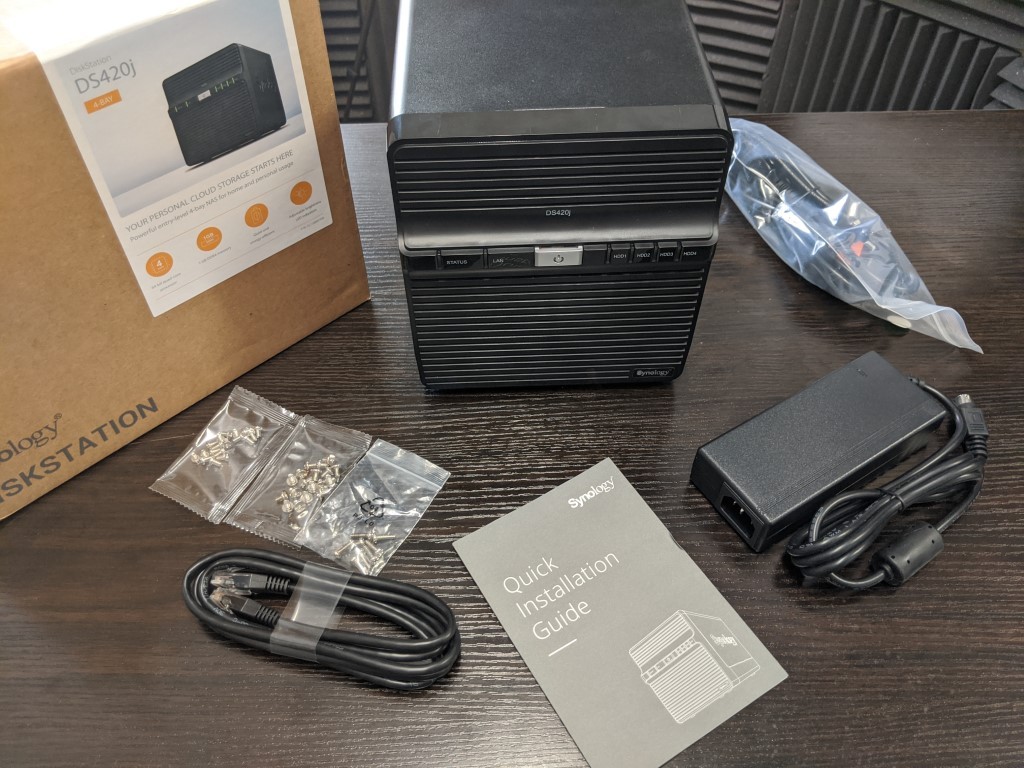
The PSU on this rather compact desktop/tower chassis NAS device is rather discreet 90W in max power, which is impressively conservative for a 4-Bay NAS. Thanks to this rather lower consumption PSU, the power consumption in real-world use is reported at a low 21.71 W (Access) and 7.88 W (HDD Hibernation).

An external PSU is something taht often divides opinion in terms of its use, with some users preferring it’s easy of replacement and a-b testing in the event of a bootup issue, whereas others find an external PSU problematic in terms of desk clutter and potential of accident disconnection. This is merely a matter of personal preference, so I will hold off judgement on this.
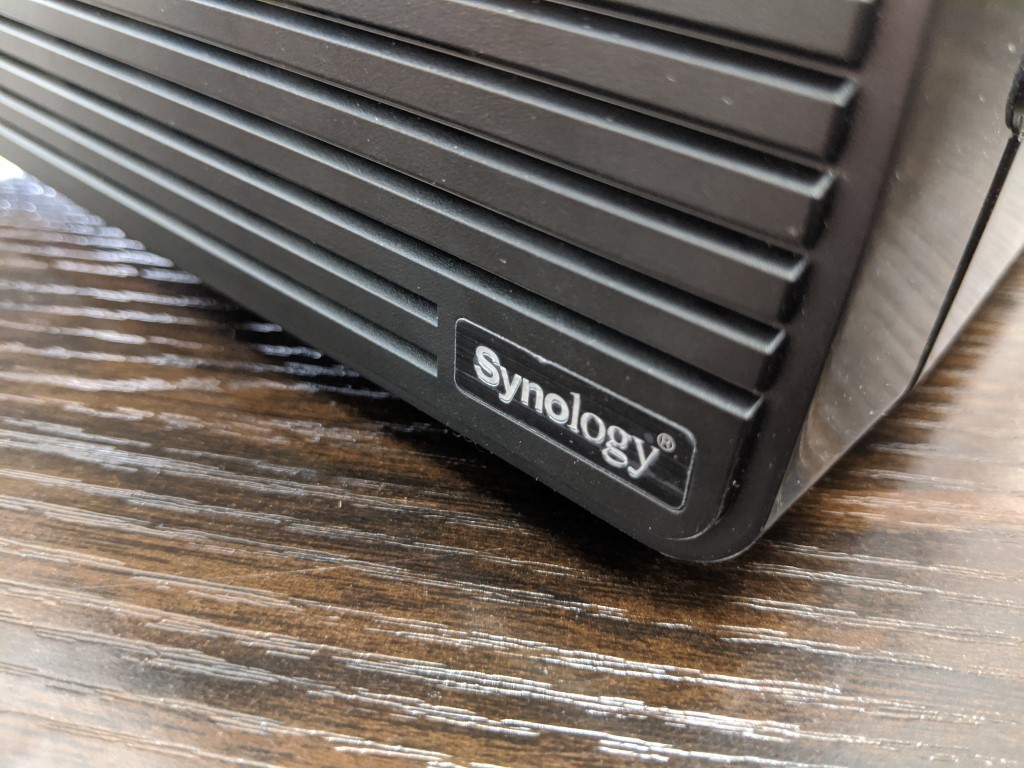
Synology DS420j NAS Drive – Design
The rather unique looking chassis (for those that are new to the Synology J series NAS range) is something that provides good coverage of ventilation and rigidity. Measuring 18.4cm x 16.8cm x 23cm, this is a near-identical chassis to that of the DS418j that was released back in autumn 2017, and arrives with many similarities to its predecessor.
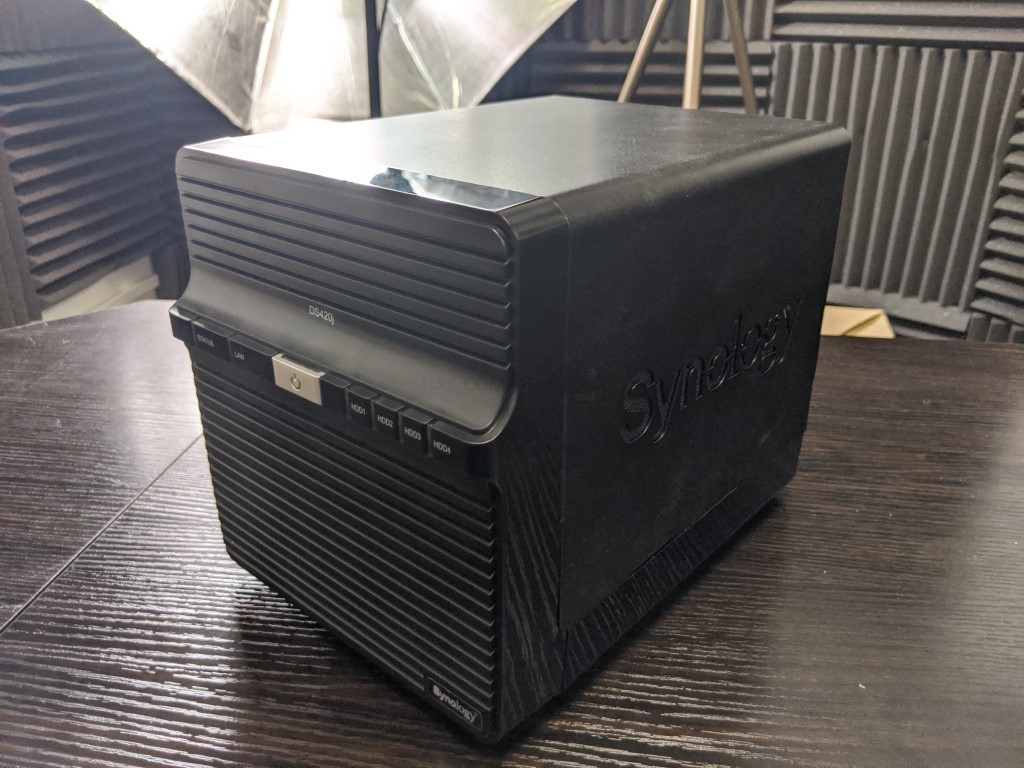
The chassis design is another area of the popular 4-BayJ series that has always been a bit hot/cold by the buyers. It looks very retro in both shape and design, with early units arriving in white and looking like a toaster, these newer generation devices and their black metal casing are a lot easier on the eye. Arriving as a closed system, they do not support hot-swapping with removable bays whilst the unit is in operation.
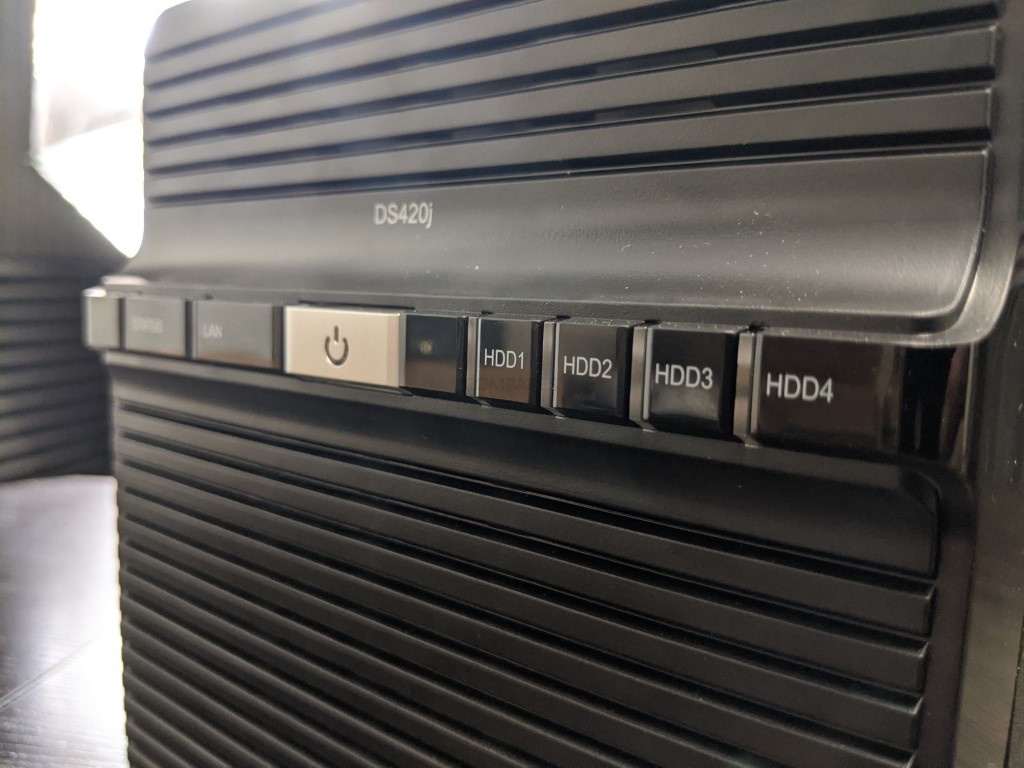
The front centre strip acts as your information and access point, arriving with LED lights that denote system access, network activity, HDD/SSD access and just generally highlighting that the device is in operation. This also features the power button and a series of various LED colours that indicate the health of the activities.

One area that the Synology DS420j NAS covers more than almost any other NAS is in the area of ventilation. The chassis arrives with above and beyond ventilation coverage, with the front panel that, although not removable, provides a fantastic amount of passive cooling to work with the active fans on the rear of the casing.
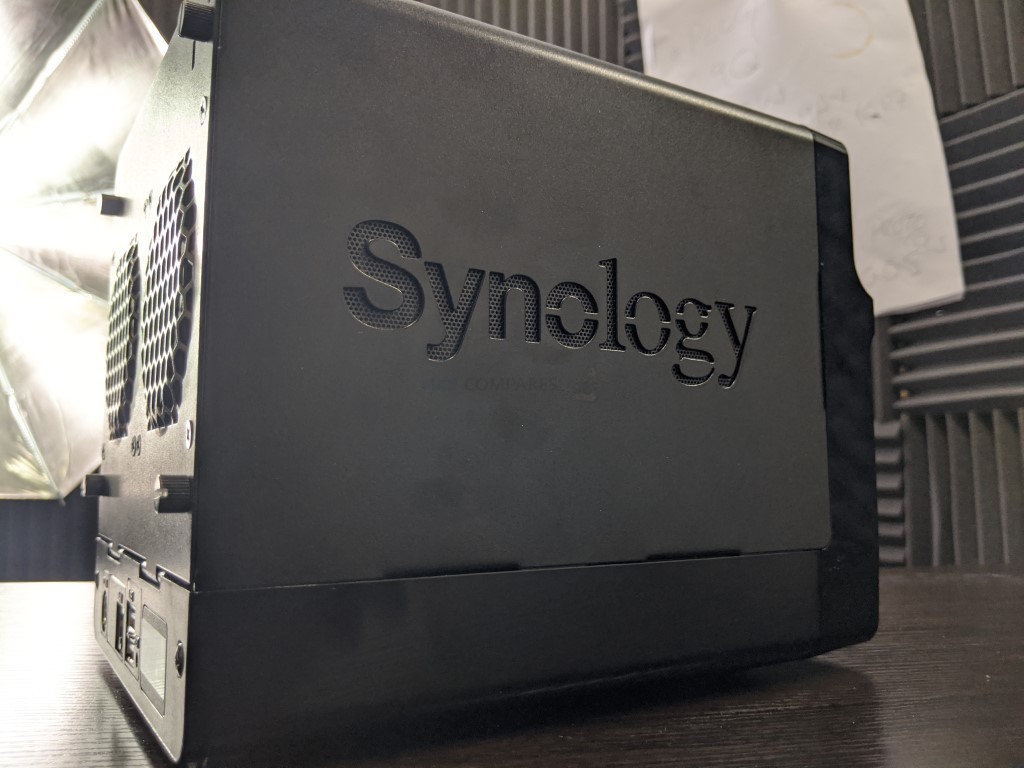
This ventilation is carried a step further, with each side of the DS420j NAS featuring the Synology logo, that is fully ventilated and adding to the present passive cooling and ventilation. The chassis is a combination of metal and plastic, with the majority going to metal construction. Although this may seem remarkably rigid, it is worth highlighting that once the device is fully populated, a combination of light drive vibration and the framework result in a recorded 20.6 dB(A) noise level when in use.
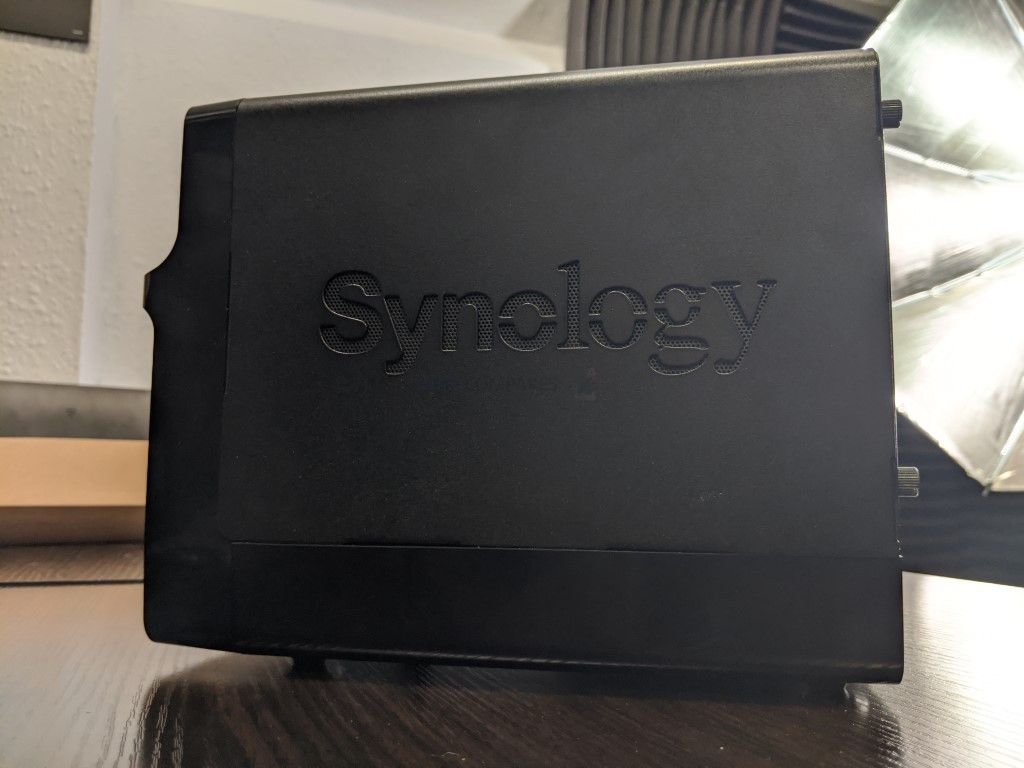
The Model ID is clearly defined on the front of the chassis in the corner, but quite discreetly and in keeping with the Synology design aesthetic of diskstation NAS.
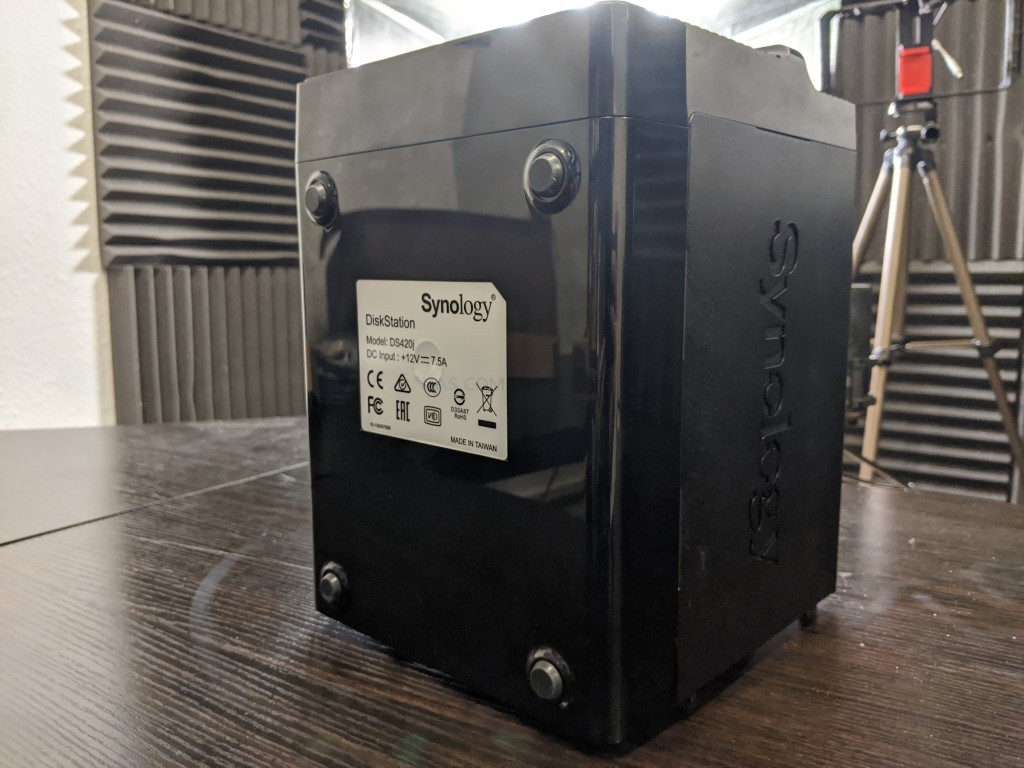
The base of the DS420j is fairly non-discript but does feature four rubberized feet to control vibration whilst the device is in operation but did not feature a vast amount of further cooling. This chassis design is near identical to that of the DS416j and DS418j and that is not a bad thing, though of course, some have their reservations on the casing choices.
Synology DS420j NAS Drive – Connections and Ports
Just like any other Synology NAS drive, the DS420j features a few different ports on the rear of the case. In terms of their ability and coverage, you really are getting the bear minimum with the DS420j NAS as it is designed with budget concerns very much at the forefront.
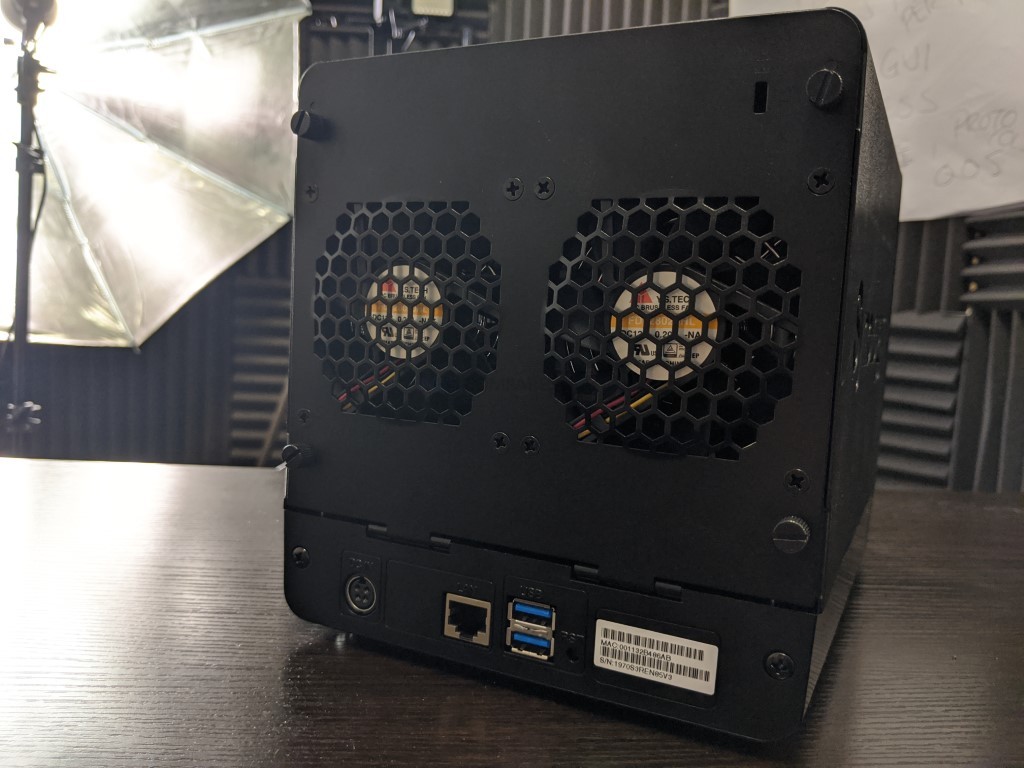
In terms of connectivity, the DS420j arrives with USB Ports (again, like most other NAS drives) that can be used for a multitude of devices, such as USB Storage devices, supported WiFi dongles, UPS heartbeat devices and more. There are two ports that can be used for many uses within the Synology DSM software on the DS420j, but for those that are new to NAS drives, let me confirm that you CANNOT use these for direct access to the NAS drive. In short, these are designed to be used with the NAS as the host devices and the connected USB devices as a client/accessory device.

One area I was a little disappointed in on the DS420j NAS is the use of 1Gbe in 2020. I understand that this is designed to be a cost-effective NAS solution, but given the rise and relative inexpensive of 2.5Gbe as an alternative to RJ45 1Gbe, I am surprised that it did not get featured on this 4-Bay budget NAS. Additionally, although this device features a much competitive CPU in the DS420j vs DS418J, it still features a low memory choice which will always cause issues when trying to push the abilities of your storage.
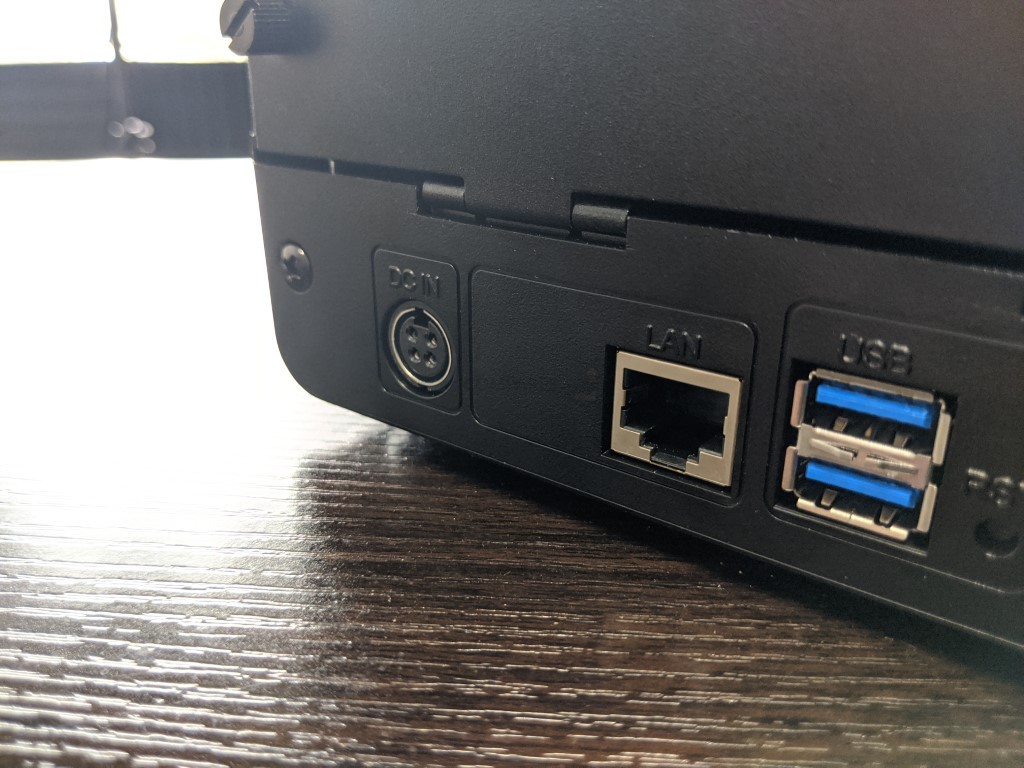
The 1Gbe connection of the DS420j provides a decent 100MB/s+ Read and Write in regular and non-stressed operation in files and communicate with the NAS. This is pretty reassuring given the ARM-based CPU inside the NAS and how that would translate into low speeds normally.
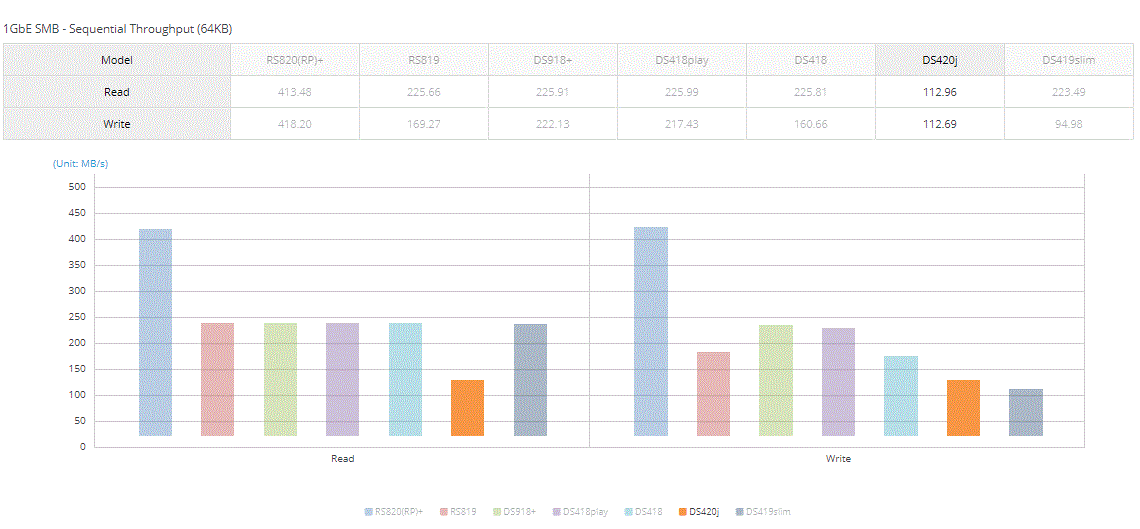
However, when you enable AES 256bit encryption, that CPU (despite its 64bit architecture) really does struggle to stay on top of things, resulting in some surprisingly poor Upload/Download speeds of multiple files in the NAS at once.
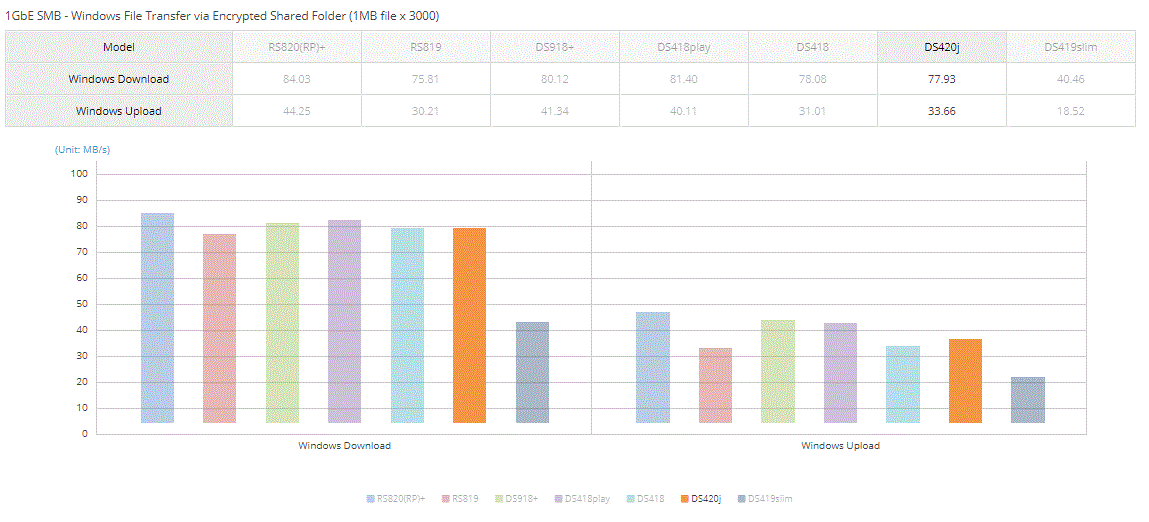
None of this is a huge surprise, as this is a cost-effective solution, but it is still worth noting, as those looking for lighting fats transfers are going to be painfully disappointed.

The rear fans of the Synology DS420j NAS are assisted by all of the passive cooling mentioned previously on the sides of the chassis. However, these fans are a pinch smaller than those found on other 2-Bay NAS drives and also involve a much more unique means to remove and clean as needed.
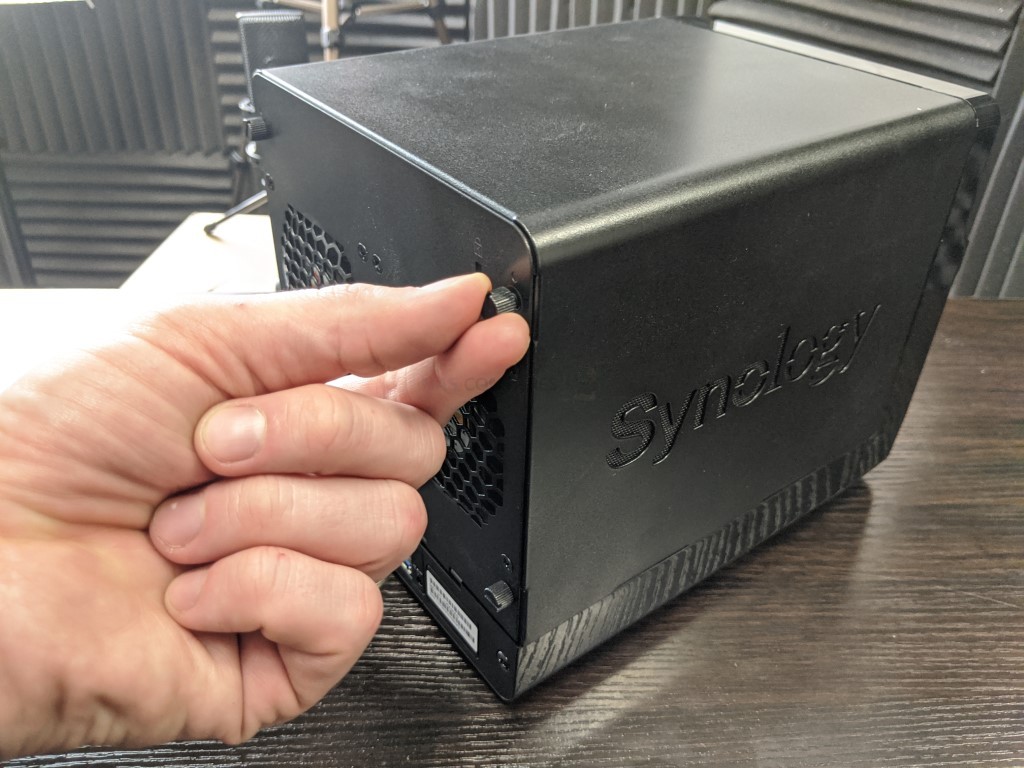
Lifting the fear of the chassis shows just how the hard drives and SSD can be installed. With the top of the metal chassis being removable with the rotation of two thumbscrews, we can take a good look inside the DS420j NAS.

As you can see, those two rear fans are a great deal more exposed here and you can see the means to clean them as needed, as well as see how they connect with the internal board. It is worth highlighting that the fan rotation (much like the front-mounted LEDs) can be adjusted automatically or manually, for noise and heat control. However, I strongly advise you to leave this as an automated setting, as it is not rocket science and better than the internal core temperature is monitored 24×7 by the system itself.
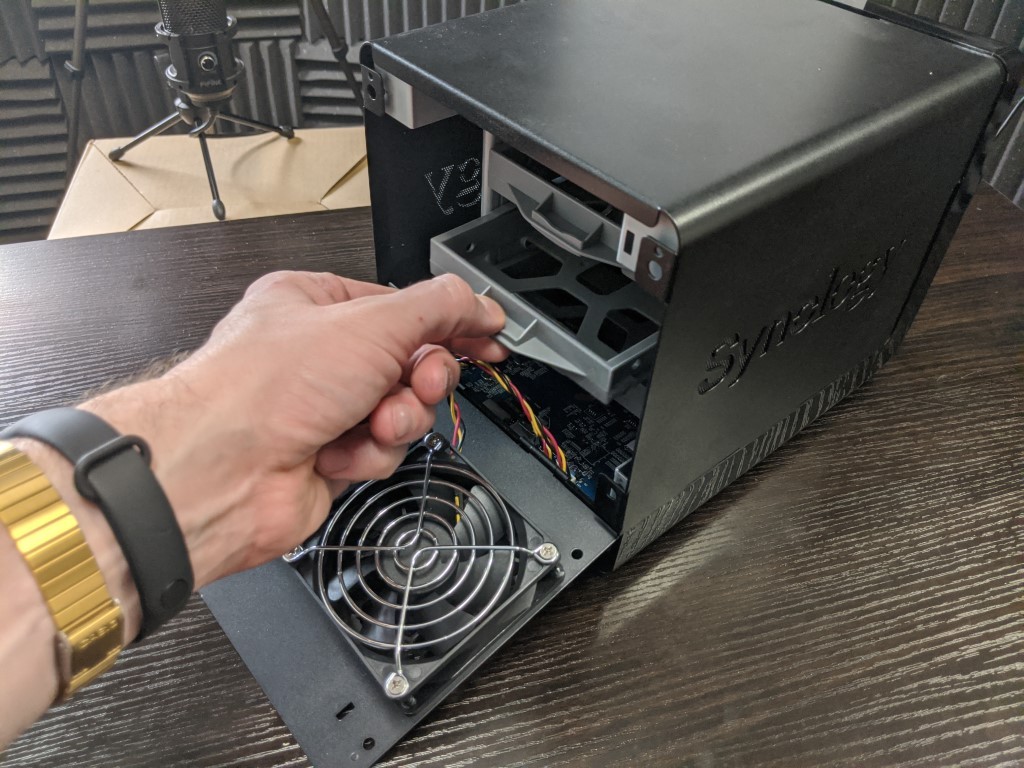
Opening up the inside a little further shows us where the HDD/SSD media can be installed. Although this device does support 2.5″ SSD drives, I think it is safe to say that 99% of users who buy such a budget solution, will do so with HDDs in mind. This device can function with just a single hard drive (and allows adding drives later in SHR/RAID5/RAID1) upto 16TB in the Seagate Ironwolf 16TB NAS drives and WD Red 14TB

Removing bays from the DS420j NAS is surprisingly easy and although the device does not include any tools, Hard Drives are installed using the screws from the accessories pack included in this retail kit. There are 2.5″ screw holes too, so you are still able to install SSDs if you feel that way included, designate it’s budget stature.

Synology DS420j NAS Drive – Internal Hardware
The Internal hardware of the Synology DS420j is actually rather familiar. That is because it is remarkably similar to that of the DS418 4-Bay NAS drive. Arriving with a Realtek RTS1296 4-core processor this new NAS arrives with a very good ‘efficient’ CPU. The processor inside is a Realtek RTD1296 1.4Ghz CPU, twice the CPU cores of the older DS418j. This processor is backed up with some DDR4 memory support, much like the predecessor. However, it arrives with just 1GB, which although the most taht you can find in any of the Synology J series (the DS120j at 512MB and the DS220j at 512MB), it is still a rather small amount, especially given the potential of that Realtek 64bit ARM CPU. I will go into a little more detail later, but there is no avoiding that this 1GB memory certainly serves as a massive bottleneck.
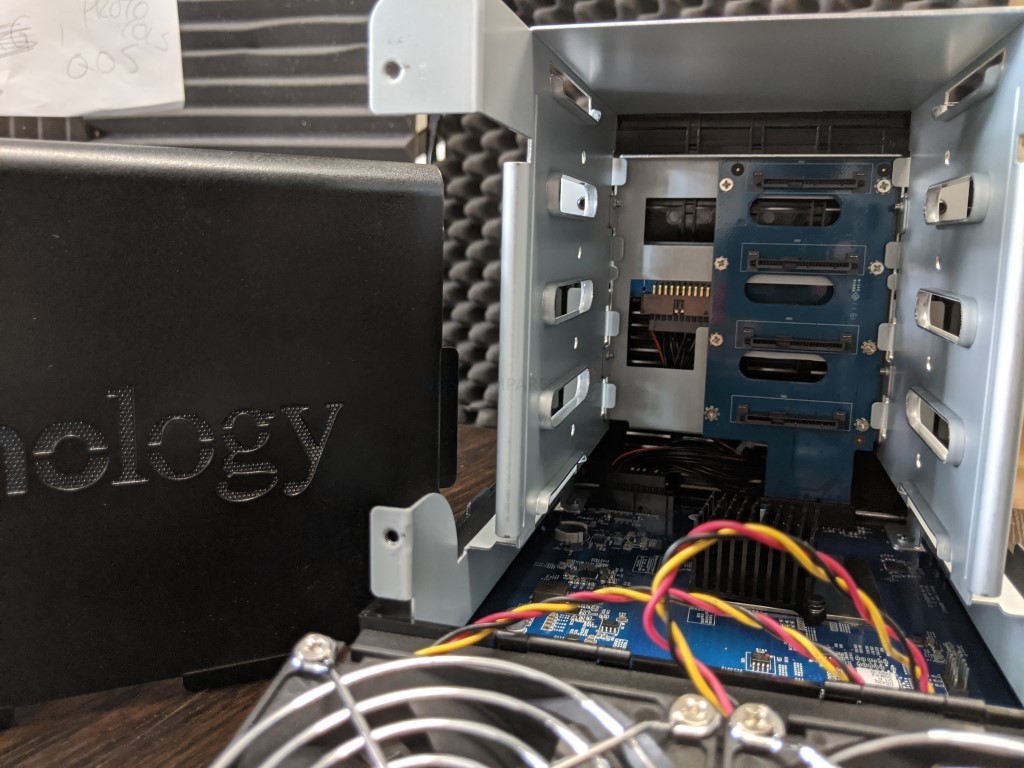
That memory cannot be upgraded and although it arrives as a great base with which to being your Synology NAS user experience when your libraries of data and services on the DS420j NAS are better established and being accessed by multiple client devices, that 1GB memory will result in slowing access by multiple users at once, Surveillance camera use and more. If you are a home user looking to create some low key (non-mission-critical backups) or stream multimedia to your home consoles and TVs, it is a great choice. Additionally, the RAID 5 and Synology Hybrid RAID support of the 4 Bays means that you have a very scalable solution at this price threshold. Yes, the chassis is a little odd-looking, but the hardware is very well put together and will give you a great day 1 DSM 6.2 experience.
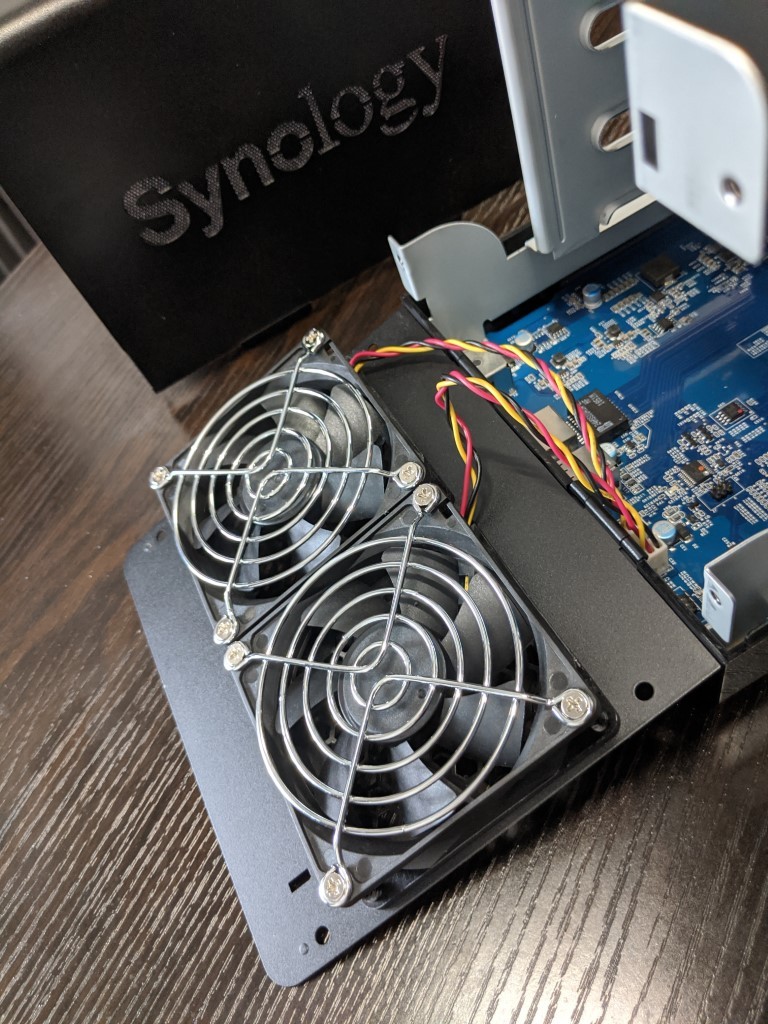
Despite this the competence of the Synology DS420j NAS and it’s ability to support low/easy end file transmission, it is not the quietest 4-Bay on the market. In fact, if you are working in relatively close proximity to the DS420j, you will be very aware of this NAS. As mentioned, this is because of the chassis/frame of this device and certain design choices that I have never really understood by Synology in this chassis. To put it into perspective, the DS420j arrives with a near IDENTICAL 4-Bay from the previous Generation, the DS418. The latter arriving with 2GB of memory (so 1GB higher) and 2 LAN ports, it still featured 4-Bays and that RTD1296 CPU. However, the DS418 used the much more familiar Synology plastic+removavble trays chassis (also found in the DS418play and DS918+) and to year at least, generates a lower level of sound (vibrations, fans, etc) than any of the DS420j/DS418j/DS416j NAS drives. So the continued use of this chassis (beyond making them appear different in range for comparison) has always escaped me.
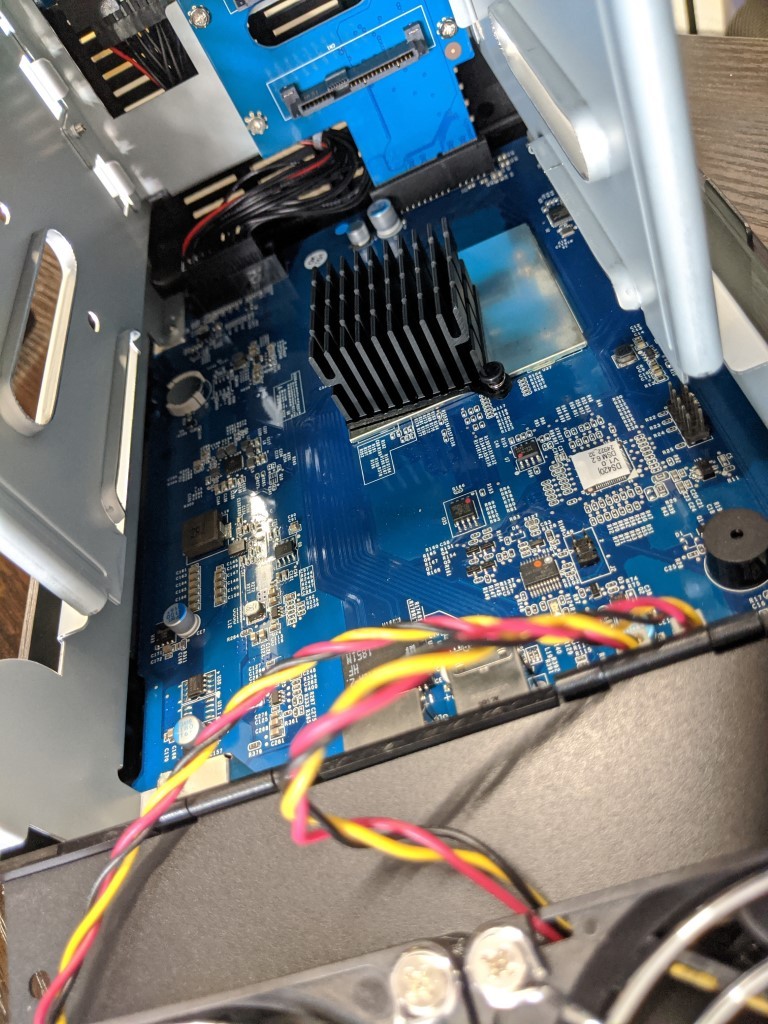
Synology DS420j NAS Drive – Software
The DS420j NAS arrives with the popular Synology GUI and operation platform, disk station manager. This operating system arrives with many, many applications available for free download once the DS420j is setup. Alongside this, there are client applications for PC/Mac systems, as well as mobile applications that suit many needs of data types for iOS and Android. But let’s discuss the elephant in the room – let’s talk about how that internal hardware mentioned earlier of the Synology DS420j 4-Bay NAS impacts the individual Synology NAS software in DSM 6.2. Because of the remarkably affordable price tag of this device, the internal hardware is pretty low compared with modern standards and although it is 100% better than DS418j in terms of the CPU (with 4 cores compared with 2), it arrives with the same 1GB of DDR4 memory (which cannot be upgraded. That means that in general terms compared with other Synology Plus series NAS, this diskstation is designed to be economical in more than just the price tag. That said, I was still very surprised at the number of apps that is did arrive with:
It will certainly support features and functionality such as DLNA media playback too network devices, multiple backups from PC/Mac systems, multi-user file access and sharing folders. It even supports desirable Synology first-party apps such as Synology Drive, Synology Moments (particularly impressed by that one) and even surveillance station, supporting upto 16 Cameras at once. Synology J series NAS drives were never designed to completely show off everything a Synology NAS can do and the DS420j is not going to be your powerhouse NAS solution. It is designed to work as your entry point into NAS, as a low-end RAID 5 enabled, data sharing solution, or as a network backup to an existing network storage setup in the background. Typically with this Realtek 64bit CPU, we have seen quite alot of potential. When this RTD1296 CPU has been featured on previous NAS drives from Synology (the DS418, DS218, DS819 to name a few) we have seen it support Plex Media server, 15-20 cameras in Surveillance station, BTRFS as a file system, 4K Support and more. However, this it is a VERY DIFFERENT story with the Synology DS420j, as that 1GB DDR4 limit is going to prevent a number of these software packages being able to run.
You will get a good base level experience in DSM 6.2 (and no doubt in DSM 7.0 later), but the fact the DDR4 memory cannot be expanded (you cannot even reach the module and consider swamping anything out without significant disassembly, MASSIVELY voiding your warranty) is something that will result in your usage of the device for multiple users/devices/applications at once hitting ‘99% Memory Usage’ happening sooner than you would like. Additionally, the fact that this also resulted in alot of the cool things this CPU can do being nerfed (BRTFS, 4K Transcoding, etc) means that by it’s very design, you have a DSM experience that has been streamlined because of a simple drop from 2GB to 1GB of memory – which in terms of production costs is fantastically small, serving you to feel like this was an intentional move to keep product families separate. All this aside, if you are a home user, small shop owner or a business looking for central backups and shares that are not going to be fantastically taxing, the DS420j NAS Software support will certainly do the job.
Synology DS420j NAS Drive – Review Verdict
Straight away, let’s be clear about this – I DO like the DS420j NAS. Reading over this review, there are times that I sound like I do not, but I do. It is a very, very competent device and Synology should be proud of this new release to their ever-growing J Series of NAS devices. The fact that the 1, 2, 4 Bay 2020 J series NAS drives all seemed to arrive in a very close formation did leave me a touch concerned (with more popular Plex and Play series models seemingly still being held back in 2020 for one reason or another) but the hardware choices of these model in the latest generation of Synology NAS have doubled CPU or Memory in previous models in line with how technology has evolved forward, ensuring that the price you pay for a 4 Bay J series NAS has moved very little, but the power inside has shot up. That said, as an experienced NAS user, the low memory leaves me a little apprehensive about the future (including its support of DSM 7.0) and ti would be remiss of me not to highlight these things. In short, I am NOT the target audience for the DS420j NAS, but if I was a NAS newbie, had a tighter budget, had more solo efforts in mind, only need a network backup to my client devices (or even another NAS on the network), the nthe Synology DS420j NAS is a great solution.

Although this device will only cost you around £485 ex.VAT with 4x 2TB hard drives (Seagate Ironwolf NAS Drives) included, it can still perform the bulk of the standard tasks that are available in modern NAS and if you are looking for a universally supported DLNA or backup device, this is the one for you. Though definitely not aimed at the NAS experienced or 2nd-time buyers, or those looking for a solid foundation to build a business around where the customer data is critical. If you are looking for a network-attached storage device to act as a network backup or just want a simple NAS to do basic tasks such as media and protecting the data on your other devices, I recommend the Synology DS420j NAS. Just make sure you have an off-site backup in place (such as a study external USB drive or a third-party cloud space with which to back up your data to periodically via cloud synchronization). Lastly, as much as I recommend the DS420j, it is worth remembering that it does not multitask especially well (due to that more modest CPU and memory), so sometimes you will need to be patient. Alternatively, using the DS420j as a network backup to the rest of your storage network, it is certainly a solid and robust choice that has fantastic setup-and-forget architecture.

A Quick Request to You – Yes, you reading this!
If you plan on buying your NAS Drive from Amazon, please use the links below for the best prices and Availability

🔒 Join Inner Circle
Get an alert every time something gets added to this specific article!
This description contains links to Amazon. These links will take you to some of the products mentioned in today's content. As an Amazon Associate, I earn from qualifying purchases. Visit the NASCompares Deal Finder to find the best place to buy this device in your region, based on Service, Support and Reputation - Just Search for your NAS Drive in the Box Below
Need Advice on Data Storage from an Expert?
Finally, for free advice about your setup, just leave a message in the comments below here at NASCompares.com and we will get back to you. Need Help?
Where possible (and where appropriate) please provide as much information about your requirements, as then I can arrange the best answer and solution to your needs. Do not worry about your e-mail address being required, it will NOT be used in a mailing list and will NOT be used in any way other than to respond to your enquiry.
Need Help?
Where possible (and where appropriate) please provide as much information about your requirements, as then I can arrange the best answer and solution to your needs. Do not worry about your e-mail address being required, it will NOT be used in a mailing list and will NOT be used in any way other than to respond to your enquiry.

|
 |
Minisforum MS-02 Ultra - WHO IS THIS FOR??? (The First 48HRs)
Why People Use TrueNAS, UnRAID and Proxmox to Turnkey NAS (Synology, QNAP, etc)
Why People Prefer Turnkey NAS vs TrueNAS, UnRAID and More
The Top 5 Mistakes NAS Buyers Make
Top 5 PLEX/Jellyfin NAS of 2025
Seagate Ironwolf vs WD Red NAS Hard Drives
Access content via Patreon or KO-FI





Discover more from NAS Compares
Subscribe to get the latest posts sent to your email.





Unfortunately, this device not support Active Backup for Business to backup VMware VMs 🙁
REPLY ON YOUTUBE
Hey I figured out what the j stand for 🙂 Junk!
REPLY ON YOUTUBE
Thank yot for the video of this NAS
REPLY ON YOUTUBE
im a noob when it comes to using a nas but im looking to get one just for plex & media sharing to around 3 TVs that could be running all at the same time will this do the job & would using SSDs instead of HDDs make any difference to the way it runs ?? nas sound output & the reading speed ?? is the read speed locked to the nas cpu & ram capabilities ??
REPLY ON YOUTUBE
10:20 I except USB-4 at least in the year 2022!
Everything under USB-4 is very sad 🙁
REPLY ON YOUTUBE
What, only waffling, not a single performance test? Why do you even bother making these videos?
For example, Synology has often less memory than other brands but performs equally or better. So unless you actually fire it up and test performance, don’t waffle around that “it has only 1GB RAM”. We know how much memory it has from the spec sheet anyway.
REPLY ON YOUTUBE
There isn’t a person alive that can tell the difference between a 19 and 20dB from the couch to the AV unit on the other side of the room. Not to mention that is going to be below the noose floor of any room that hasn’t been sound treated. Not even worth talking about.
REPLY ON YOUTUBE
can 415+ keep up to this? it has 2GB ram but i guess the cpu is no no?
REPLY ON YOUTUBE
I would love to hear your choice between 220+ vs 420j
REPLY ON YOUTUBE
Can I use the USB 3 to connect direct to my pc?
REPLY ON YOUTUBE
I am interested in buying this DS420j NAS but could you please confirm if it supports SSD caching (19:31)? Because on their website this unit isn’t supported with SSD caching. Thank you.
REPLY ON YOUTUBE
i am still running a 411J and 413J as back up destinations on my network. They are a good introduction to Synology and, as the owner of 7 of these over the last decade, been wonderfully reliable.
REPLY ON YOUTUBE
Thank you for mentioning the length of the lan cable
REPLY ON YOUTUBE